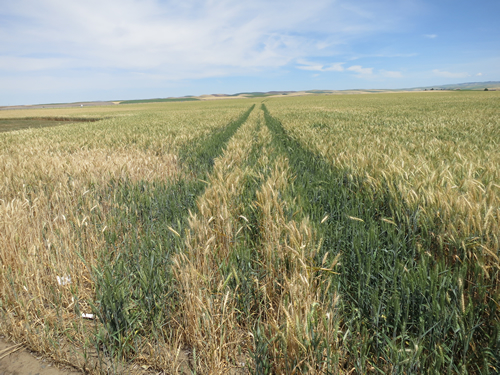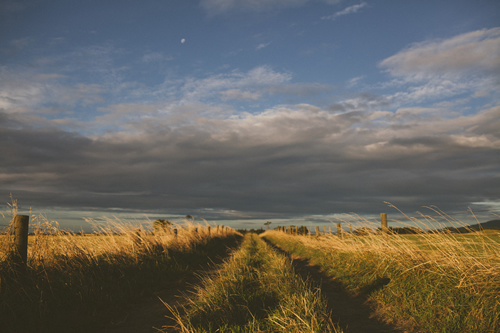How to Fall in Love with the Flatlands
Article and photo by Robert Reid
8/2014

|
|
Some view only the flatlands, other explorers are seduced by the blue skies above while their feet remain firmly on earth.
|
Mountains are nice to look at, but they tend to get in the way of a view.
I learned this crossing the Colorado Rockies by train a year ago. Spellbound by what I saw, I pressed my forehead against the California Zephyr’s window for hours, admiring glaciated peaks, dark tunnels, and deep, river-cut canyons that roads can’t reach. But then, just before Denver, everything suddenly opened up as if the sky had dropped. And I watched our planet’s surface curve before me, stretching beyond the horizon as a gray-tannish blur. It was as if a chorus of banging pots suddenly gave way to a blissful, meditative silence to soak up.
This was the greatest view I’ve ever seen. Not of a mountain, but looking across the Great Plains.
Not everyone feels this way about flatlands, I realize. In her 1993 book Dakota: A Spiritual Geography, Kathleen Norris writes how the “odd, tortured landscape terrifies many people” and that it’s sink-or-swim to love them. As she puts it, “You either get your sea legs or want to bail out.”
I’d add that to conquer the flats, you only need a little imagination, some good walking shoes, and maybe a book.
Great Plains, Ian Frazier’s short travelogue from 1989, remains a Bible for budding valentines of these subtle landscapes. After moving from New York to Montana to work on a novel, Frazier soon scraps the idea and dreams of the Great Plains instead. He takes whirlwind drives to learn if bur oaks grow at the site of Sitting Bull’s cabin (they do) or simply to ask gas station attendants the name of the local football team. After he entices a friend to visit, she gushes back, “It’s amazing here. The sky is like a person yawned and never stopped!”
Part of the secret is in the roads Frazier took: not interstates, or even Route 66, but two-laners like US 89 south from Glacier National Park, North Dakota’s “straight as a laser” Hwy 8, or the “Road to Nowhere” (US 83), which runs from the Canada to Mexico border through high plains and the occasional farm town. Not exactly your average roadtrippers’ paradise.
It was a road like this, though, that taught me a secret about appreciating supposedly boring landscapes: detour to short horizons.
Riding along I-70 through Western Kansas a decade ago, I noticed the horizon loomed miles to the south, but stopped only half a mile to the north. Wondering why, I turned off the interstate and headed towards it on a chipped backroad, soon discovering a deep break from the horizontal tableau of tallgrass, where expansively rolling contours of a prehistoric ocean seafloor gave a full mountaintop view without the altitude sickness. Half a mile behind me, those driving cars on the interstate had no idea what they had just passed.
Flatlands can surprise you this way, if you look. Particularly if you walk them.
A couple years ago, while tracking Abraham Lincoln sites in seemingly ho-hum corn country in Illinois, I took a gravel road and pulled off to park on a grass path wedged between corn and soybeans. I had read of a cemetery out there where a young Abe used to go to weep for his first love, who died as a teenager. Cornstalks stood to my shoulder, as I walked in the sun; after perhaps a mile, the path bent slightly, revealing a gentle decline where an American flag flapped atop a small crest below. There I found Ann Rutledge’s original gravesite (her remains were later moved). Lincoln’s tears were in this earth, I thought standing there. As the sky started to pinken, I picked up a dried corncob nearby as a souvenir, then waved to a farmer on a tractor on my way back. I saw no one else during my adventure. That was fun.

|
|
A grassy road leading through flatlands,
the big sky above, can take a traveler almost anywhere.
|
And here’s another thing.
Climbing a peak, or going up a skyscraper, can make you briefly feel like you’re “on top of the world” (or at least the front of the Titanic). But standing on a flatland reminds us we’re always part of the world. That we’re smaller. That’s found on ground so level that, as one 19th-century observer put it, you can sit on it and see the horizon from under a standing bison’s legs. Unlike a mountain, a plain or prairie or meadow rarely even gets named, nor has a sign-in box to mark your sense of accomplishment reaching it, like atop a “14er” peak might. Flatlands are nearly impossible to capture by photographs, meaning we must “record” them by merely being present and noticing how they make us feel.
All this is a gift for the curious. And it largely comes from the sky.
Half a century ago, Montana became “Big Sky Country” when it nicked the phrase from a 1947 novel by AB Guthrie, a local Pulitzer-winning author. Guthrie later called his Montana ranch a “point of outlook on the universe.” And it’s not like Montana monopolizes that enveloping sense the sky gives (they just branded it best).
One such place to feel the big sky is the Nebraska Panhandle’s Agate Fossil Beds National Monument. During my visit in the summer of 2001, a two-mile trail led me towards isolated buttes and prehistoric beaver tunnels. Stopping to listen to the wind bend the knee-high blades of grass around me, I realized I had all this to myself; I couldn’t find a trace of humanity in any direction.
Soon a slight dent marred my soundscape though. I looked toward a faint rumble upward, and saw a wee speck gliding across the sky: some jet going from one coast to the other. I stood there, planted in a “fly-over state,” and watched it pass, wondering if anyone was watching me back, and wondering whether they were missing anything?
I can only know I’ve never felt happier to have my feet on the ground.
Robert Reid has written a couple dozen Lonely Planet guidebooks, talked travel on TV shows like the Today Show and CNN Headline News, and writes regularly for National Geographic Traveler. He lives in Portland, Oregon.
|
